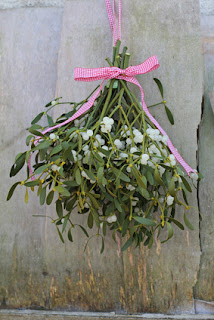Win a Highland gift set and chat
with author B.J. Scott
this week at the Book Boost!
with author B.J. Scott
this week at the Book Boost!
We're back with our featured author of the week, B.J. Scott and she has another helpful history lesson for the season and here's what she had to say...
Why do we use Mistletoe during the Holidays?
Now that we are into December many of us have started to decorate our homes for the holiday season. Tree lots are busy with wide-eyed children and families looking for the perfect pine to grace their homes. Poinsettias abound, garlands of pine or holly, colored lights and festive fruits and nuts adorn the mantle. But have you ever stopped and wondered about some of these plants and why we use them to celebrate this festive season?
Since I am a romance author, mistletoe, the plant beneath which lovers feel compelled to kiss is one that springs to mind. But why to we see this bundle of crisp green leaves and white berries so special?
Druid priests were said to use the plant in their winter celebrations more than 200 years prior to the birth of Christ. They believed it held great powers and used it for healing, infertility antidotes for poisons, and as a means to ward off evil spirits. They would cut the sprigs with a golden sickle, catching the branches before they touched the ground. They wore it in their hair, sprigs were distributed amongst the people and hung over doorways, in stables and homes as a means of protection. In the Celtic language mistletoe meant "all-heal".
Ancient civilizations like the Romans viewed mistletoe as a symbol of peace, refused to fight in the presence of the plant and would lay down their weapons, later prompting the slogan, “Peace and joy unto all men.’’
Giving a sprig to the first calf of the New Year was thought to protect the herd and placing one in a baby’s cradle guarded the infant from goblins and fairies.
In Britain, bee farmers placed a sprig of mistletoe on their hives and believed the humming of bees was in honor of Jesus.
In the Norse and Scandinavian countries, it was associated with Frigga, their Goddess of Love. They believed that when her son, Balder, was killed by an arrow made of mistletoe, shot by the evil spirit, Loki. Grief-stricken, Frigga wept tears of white berries which brought him back to life. Overjoyed, she blessed the mistletoe and bestowed a kiss on those who walked beneath it. The tradition continues to this day.
In some European countries, like France, the tradition of kissing beneath the mistletoe was reserved for New Years. But today it is acceptable to exchange a kiss any time during the holiday season.
In the eighteenth-century, the English created a kissing ball of holly, mistletoe and pine draped with ribbons and hung from the doorway or rafters. A young woman standing beneath the ball could not refuse a kiss. This exchange meant romance or lasting friendship and goodwill. If she was not kissed, it meant she would not marry in the near future, or perhaps never
At one time, Christmas was celebrated mid-winter, the New Year beginning on March 5th. During the long cold winter it was believed the howl of cold winds was that of lamenting ghosts and demons from the other world. Assorted greenery like holly, mistletoe, pine bows etc... were hung over the doors to protect the household from evil and brought inside to brighten up the homes and to freshen the air during this dreary time of year.
The next time you see a sprig of mistletoe hanging above your head, kiss the one you love and remember the lore behind the magical plant.
A Note from the Book Boost: I love this post! What a great journey through time with mistletoe. I'm going to find some this season and try to lure hubby under it! Please remind us about your last book so we can gear up for your new release coming next week.
Blurb from Highland Legacy:
Faced with an abhorrent betrothal, Cailin Macmillan flees her father's castle and quickly learns that a woman traveling alone in Medieval Scotland is an easy target for ruthless English soldiers.
When Highland patriot Connor Fraser comes to her aid, his steadfast dedication to king and country is challenged by his overwhelming desire to protect Cailin-even if he must marry her to do so.
Accused of murdering one of her attackers and determined to rely on her own resourcefulness, Cailin dresses as a lad, intent on seeking refuge at the camp of Robert the Bruce. Can she elude an enemy from her past-a vindictive English lord bent on her utter demise-or will she fall prey to his carnal intent and be executed for a crime she did not commit?
Want More B.J. Scott?
Visit her on the web here: http://www.authorbjscott.com/
Or here: http://authorbjscott.wordpress.com/
Highland Quest coming December 19th to Soul Mate Publishing!
Contest:
Leave a question or comment for B.J. any time during this week and be entered to win a copy of Highland Legacy or Highland Quest (releases 12/19/12). The winner will also receive a book thong, regular book mark, a key chain, a can cooler and a pen.







.jpg)






.jpg)

3 comments:
Thanks for posting the second blog for the week, Kerri. It is not about my book but covers some interesting history about mistletoe and why we use it at christmas.
Great story, and information, Barb. Best of luck with Highland Quest.
Thanks Callie. You're a doll for stopping by again. Appreciate it so much.
Post a Comment